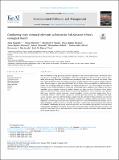| dc.description.abstract | With its booming mining, processing industries, agriculture, and increasing urbanization, sub-Saharan Africa experiences an alarming rise in accumulation of toxic chemical elements in all environmental matrices threatening entire ecology. Most toxic chemical elements are mercury, lead, cadmium, chromium, and arsenic. These toxic chemical elements are known human carcinogens, systemic toxicants and can induce multiple organ damage. The occurrences of toxic chemical elements in Sub-Saharan Africa are amplified by anthropogenic activities such as mining, industrial discharges, and agricultural practices. This study examined the extent of exposure to toxic chemical elements in surface and underground waters, sediments, soils, effluents, food crops, vegetables, aquatic organisms, industrial products, humans, and other animals in Sub-Saharan Africa. Results indicate occurrences of toxic chemical elements in surface and underground waters, sediments, soils, effluents, food crops, vegetables, aquatic organisms, industrial products, humans, and other animals above the recommended threshold. These findings highlight the persistent pollution of water, soil, sediments, food crops, aquatic organisms, and even industrial products, emphasizing the potential for bioaccumulation and exposure through the food chain. This requires interdisciplinary approaches, including updating and enforcing stricter regulations tailored to regional industrial and agricultural practices. Advanced remediation technologies, such as phytoremediation, and bioremediation, should be prioritized to remove toxic chemical elements from affected environments. Additionally, promoting sustainable practices, such as waste recycling programs, can help reduce anthropogenic contributions, strengthen environmental monitoring systems, nurture community awareness, and essentially encourage regional and international collaboration to protect ecosystems and safeguard human health in Sub-Saharan Africa. | en_US |

